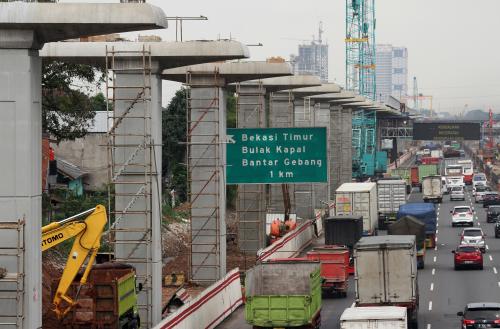Editor’s Note: This is the first in a series of analyses, “Food, Fuel, and Finance: How Will the Middle East Weather the Global Economic Crisis?”, by the Middle East Youth Initiative on the impact of the global economic slowdown on Middle Eastern countries. While the Middle East is expected to maintain strong economic growth, we will explore the impact of the adjustments in commodity prices and the financial crunch on oil and non-oil exporting countries. Will long-term reforms enable the Middle East and its millions of young citizens to compete in a global economy which is now more uncertain and volatile?
Recent turmoil in the world financial markets has spilled into oil and other commodity markets. Oil prices have fallen by nearly one-half from their peak in July 2007 and may fall further as the financial crisis drives the economies of the major Western countries into recession. Judging by the large drops in the region’s key stock markets—they have fallen from 30 to 50 percent this year—the recent economic boom is already over. If the price of oil slides to below $50 per barrel, it will cause a broader economic crisis with rising unemployment, threatening the fragile political balance in the region today.
The last time a high price gave way in 1986, it was for the same reason: a recession in the Western economies. In August 1986, prices plunged to about $10 per barrel and sent the economies of the oil rich countries of the Middle East into a long recession, raising levels of popular resentment against the region’s governments. Reversals of fortune in oil exporting countries tend to be more politically charged than elsewhere because they raise questions about the management of the large inflow of wealth that precedes retrenchment. What are the lessons from the oil price collapse of the 1980s for governments in the region today?
Is the global slowdown causing the price of oil to collapse?
Is a large price collapse even possible, given all of the talk about global energy shortages? The basic economics of the oil market indicate that it is not only possible but in fact quite likely. With inelastic demand and supply, large price changes can result from even small changes in the balance of supply and demand. Recession in the Western economies coupled with several years’ worth of investment in energy-saving equipment worldwide will continue to lower demand for oil in the coming months, despite falling prices and continued growth in India and China.
To prevent a glut in the global market and to shore up the price of oil, OPEC will step in to administer output cuts. Their emergency meeting later this month may well draw up a new, lower set of quotas but, if the past is any guide, setting quotas is one thing and enforcing them another. As demand shrinks, all oil producers are tempted to compensate for the lower price by increasing output. OPEC’s pleas to its members to abide by quotas will fall on deaf ears and prices will stay on a downward spiral amid blame and finger pointing. In a normal market, the price drop by itself would rejuvenate demand, reduce supply, and eliminate the glut. But the market for oil is no ordinary market: demand is unresponsive in the short run because it is tied to fixed investment in equipment, and supply is not only inelastic it may be backward bending.[1]
If these events were to unfold according to the scenario that played out in the 1980s, Saudi Arabia would soon be expected to step in and take unilateral cuts in production. It would seem reasonable for them to do so because, by now, they are supposedly exhausted from pumping too much oil to keep prices from rising too much, and this would be a good time to step back. But, their experience in the 1980s tells them otherwise. Then, small cuts turned into larger cuts as other OPEC members offered discounts, cutting expensive Saudi oil exports by half and turning their current account from a surplus of 25% of GDP in 1980 into a deficit of 15% in 1984. After repeated threats, in August 1986 Saudi Arabia resorted to “netback pricing,” offering buyers the lowest price. Within a week, the world price for oil fell to $10 per barrel. This was a hard lesson for the Middle East to learn. This time Saudi Arabia may not wait as long to defend their market share, which means that, barring unexpected disruptions in supply, prices may fall sooner rather than later.
Managing the reversals in oil prices and in expectations:
There is little indication that policy makers in the oil rich nations of the Persian Gulf have made plans for a return of oil prices to levels below $50 per barrel. They are not alone in thinking that “cheap oil” is a bygone era. Government expenditures in Iran, Kuwait, Saudi Arabia, and UAE increased on average by 15-20% per year in real terms in recent years.
However, despite rising expenditures and expectations of lasting high prices for oil, the sheer size of the increase in oil revenues enabled these countries to enjoy large trade surpluses and to accumulate large savings. These savings will cushion the fall in oil prices but will not be enough to prevent an economic downturn. Saudi Arabia has enjoyed a trade surplus of about 25% of GDP in the last four years, which it has used to build a significant sovereign fund. Iran’s more modest surplus of about 10% of GDP has helped build up the Oil Stabilization Fund, but it is too small (equivalent to less than six months of imports) to smooth expenditures over the medium term. Last year the combined surplus of Kuwait, Saudi Arabia, and the UAE was over $200 billion but, at the rate expenditures have been rising, these surpluses will disappear within a year or two.
For these governments, the pressure to cut back on expenditures is already being felt, so their external savings are unlikely to stave off economic slowdown or even recession. In the 1980s, financial surpluses of the same order of magnitude gave way to deficits in just a few years. Once the oil market began to slide in 1983, Saudi Arabia ran a current account deficit every year for the next 12 years. The decline in the oil market brought economic stagnation not just in the oil rich countries, but in the region as a whole. Between 1983 and 1987, GDP per capita (in 2000 PPP dollars) was down by 20% in Saudi Arabia, 17% in Iran, and 32% in the UAE. Only Kuwait managed to keep the decline to less than 2 percent.
For these countries, bringing their economies to a soft landing may prove much easier than managing the downsizing of expectations without a political backlash. Leaders in the region have offered scant warning to their citizens regarding the end of the petro-boom. Even after the global financial crisis had begun, mega projects were being announced in the GCC as if to defy the reality of what the global downturn will do the region’s economies. In Iran, where populist politics has been riding the oil boom in recent years, the appetite of the Ahmadinejad government for social spending has doubled the rate of inflation in just one year, and has raised expectations to a point that even a stable level of expenditures is bound to disappoint. In 2008, when the government should have been adding to the Stabilization Fund, it made its largest withdrawal. Recently, Iran’s Central Bank governor warned that if oil prices do not recover, oil revenues will fall by $54 billion, which is more than half of their current level.
Private investors and ordinary citizens in the region are still hanging on to unrealistic expectations about the future of their economies. Unfortunately for the region’s political leaders, no one will blame the private sector for failing to predict the downturn when these expectations fail to materialize: citizens will blame the government for mismanaging the economy.
The challenges that governments face now are more difficult than those they faced after the end of the oil boom in the 1980s, and the region seems politically more volatile. While recent economic growth has created vast improvements in the standard of living and in infrastructure, it has not generated enough good jobs, especially for youth. In the GCC, dual labor markets have created millions of jobs for immigrant workers, but large sections of national youth remain unemployed, many spend years waiting for high paying government or private sector jobs. With cutbacks in government expenditures, their waits will likely be longer than they had anticipated. In the countries with the largest youth populations—Saudi Arabia and Iran—youth unemployment is in excess of 25%. The challenge is particularly daunting for Saudi Arabia: While Iran’s youth bulge is shrinking, Saudi Arabia’s is growing.
The one bright spot in all of this is that hard times make the case for policy reform more persuasive. The oil rich countries have a list of policy options before them, including reorienting education away from mere seeking of formal degrees toward acquisition of skills, transforming the search for government jobs into a search for careers in the public or private sector, and giving the youth a greater voice in shaping their own destiny.[2] With the oil feast all but over, the time has come to set the incentives for the region’s youth to become tomorrow’s productive middle class.
[1] For more on this, see Krugman’s analysis in http://krugman.blogs.nytimes.com/2008/07/19/oil-outlook/ and http://web.mit.edu/krugman/www/opec.html.
[2] For a discussion of these policies, see: Djavad Salehi-Isfahani and Navtej Dhillon, “Stalled Youth Transitions in the Middle East: A Framework for Policy Reform.” Middle East Youth Initiative Working Paper. (October 2008).



Commentary
Op-edSlipping Oil Prices: Is the Oil Rich Middle East Prepared?
October 21, 2008